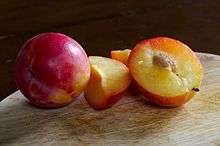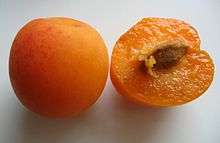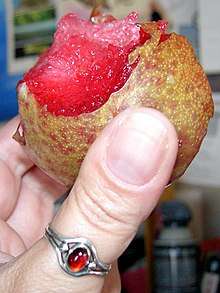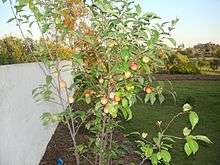Pluot
Pluots, apriums, apriplums, or plumcots, are some of the hybrids between different Prunus species that are also called interspecific plums. Whereas plumcots and apriplums are first-generation hybrids between a plum parent (P. salicina or P. cerasifera or their hybrids) and an apricot (P. armeniaca), pluots and apriums are later-generations.[1][2] Both names "plumcot" and "apriplum" have been used for trees derived from a plum seed parent, and are therefore equivalent.

| Look up plumcot, pluot, or aprium in Wiktionary, the free dictionary. |
Plumcots and apriplums
Natural plumcots (also called apriplums) have been known for hundreds of years from regions of the world that grow both plums and apricots from seed.[3] The name plumcot was created by Luther Burbank.[4] The plumcot tree can reproduce asexually by budding whereas the apriplum tree resulted from hybridized seedlings and cannot reproduce.
Pluots
Pluots /ˈpluːɒt/ are later generations of complex hybrid between the Japanese plum, Prunus salicina (providing the greater amount of parentage), and the apricot, Prunus armeniaca.[5][6] The fruit's exterior has smooth skin closely resembling that of a plum. Pluots were developed in the late 20th century by Floyd Zaiger.[7]
Apriums

Apriums are complex plum-apricot hybrids that show primarily apricot traits and flavor.[1] Apriums resemble apricots on the outside. The flesh is usually dense and notable for its sweet taste due to a high content of fructose and other sugars.[6] Apriums are usually only available early in the fruit season, like apricots and unlike pluots, which include some very late-ripening varieties. Aprium trees grow quickly and are smaller compared to other common home-grown apricots. The fruit is gold, with red coloration. Semi-mature fruit is hard and does not ripen if picked before completely mature.
Varieties
Plumcot varieties

Plumcot varieties include:
- Flavorosa: very sweet, medium-sized, flat round dark-purple fruit with red flesh, early ripening
- Flavor Royal: very sweet, medium-sized, dark purple with crimson flesh, early ripening
- Eagle Egg: very sweet, medium-sized, dark red with crimson flesh, early mid season
- Amigo: rosy plum flavors with a hint of berry, red skin with red bleeding to yellow flesh, early mid season
- Tropical Plumana: sugary tropical punch flavor, medium-sized, red over greenish yellow background with yellow flesh, early mid season
- Crimson Sweet: sweet flavor, medium-sized, crimson skin with pinkish flesh, mid season
- Dapple Jack: medium size with mottled pale green, red-spotted skin, red juicy flesh, late mid season
- Sweet Treat: super sweet with hints of Thompson grape flavor, green, golden skin with yellow juicy flesh, late mid season
- Flavor Queen: medium to large size, very juicy flesh, very sweet, golden yellow when fully ripe, late season
- Flavor Grenade: large size, oblong shape with red blush on green background, crisp, refreshing pineapple and juicy apple flavor, late season
- Summer Punch: medium to large size, very juicy flesh, very sweet with berry and melon undertones, late season
- Tropical Sunrise: Yellow to orange color skin with red blush and orange flesh, sweet plum and apricot flavors
- Flavor King: fruit punch flavor, medium size, with burgundy skin and red, super sweet, juicy flesh, late season
- King Kong: very large size with black skin, plum-like flavor with hints of almond
- Flavor Fall: large size, average flavor, red skin with yellow flesh, very late season
Pluot varieties


Pluot varieties include:[8]
- Dapple Dandy: large size with mottled pale green to yellow, red-spotted skin, red or pink juicy flesh, firm flesh, moderately late ripening.
- 'Dinosaur egg' is a trademarked name for Dapple Dandy variety.
- Early Dapple: good flavor, medium-sized, mottled green over red skin with pink flesh, early ripening
- Emerald Drop: medium to large size, green skin and yellow-orange flesh, moderately late ripening
- Flavor Delight: medium-sized, fuchsia-honey colored skin with pink flesh, early ripening
- Flavor Fall: large size, average flavor, red skin with yellow flesh, late ripening
- Flavor Finale: medium to large size, purple-red skin with amber-red flesh, exceptional complex flavor, late ripening
- Flavor Grenade: large size, oblong shape with red blush on green background, yellow juicy flesh, moderately late ripening
- Flavor Heart: very large, black with a heart shape, and yellow flesh
- Flavor Jewel: sweet flavor, heart shaped, red over yellow skin with yellow flesh
- Flavor King: Fruit punch flavor, medium size, with burgundy skin and red super sweet juicy flesh, moderately late ripening, flesh is hard until fully ripe
- Flavor Prince: large round and purple, with red flesh
- Flavor Penguin: medium size, early ripening grown in a humid climate
- Flavor Queen: medium to large size, very juicy flesh, very sweet, golden yellow when fully ripe, midseason
- Flavor Rich: medium-sweet, large black round fruit with orange flesh
- Flavor Royal: very sweet, medium-sized, dark purple with crimson flesh, very early ripening
- Flavor Supreme: medium or large, greenish purple skin, juicy red flesh
- Flavorich: large size, dark purple skin and firm, sweet, yellow-orange flesh, moderately late ripening
- Flavorosa: very sweet, medium-sized, flat, round, dark-purple fruit with red flesh, very early ripening
- Geo Pride: medium size, red-skin and yellow flesh, balanced acid-sugar, predominately sweet with unique plum/apricot flavor, moderately late ripening
- Raspberry Jewel: medium, dark red skin, brilliant red, honey-sweet flesh[9]
- Red Ray: medium, bright red with dense, sweet orange flesh
- Splash: small to medium red-orange fruit, with very sweet orange flesh, midseason
Aprium varieties
Aprium varieties include:[10]
- Cot-N-Candy : harvests in early to mid June, flesh is extra sweet and juicy, with a plummy aftertaste, size is 2.0 to 2.5 inches in radius on average, self-fruitful
- Flavor Delight : resembles an apricot, but with a distinctive flavor and texture all its own, pleasant, lingering aftertaste, bigger crops if pollenized by any apricot
- Tasty Rich Aprium: Very early harvests, in May. Light yellow-orange, firm, freestone. Flavor predominantly apricot, with pleasant aftertaste
See also
| Wikimedia Commons has media related to Prunus pluot. |
| Wikimedia Commons has media related to apriums. |
- Nectaplum
- Peacotum
- Prunus brigantina, an apricot species with smooth-skinned fruit
- Prunus dasycarpa, an apricot hybrid known as "black apricot" or "purple apricot"
References
- Chip Brantley (2009). The perfect fruit: good breeding, bad seeds, and the hunt for the elusive pluot (snippet view). New York: Bloomsbury, USA.
- Brantley, Chip (2009-08-19). "Plu-What? What's the difference between pluots and plumcots". Slate.
- Okie, W.R. 2005. Spring satin plumcot. Journal of American Pomological Society. 59(3):119-124.abstract
- J. Whitson; R. John; H.S. Williams, eds. (1914). "Chapter 7: How far can plant improvement go? The crossroads — where fact and theory seem to part". Luther Burbank: his methods and discoveries and their practical application. 1. Luther Burbank Press. pp. 211–244.
- "Pluot". Oxford University Press. 1 January 2019. Retrieved 20 January 2019.
- Ingels, Chuck; et al. (2007). The Home Orchard: Growing Your Own Deciduous Fruit and Nut Trees. University of California Agriculture and Natural Resources. p. 33.
- Okie, W.R. 2005. Spring satin plumcot. Journal of American Pomological Society. 59(3):119-124.
- Centers for Disease Control, Fruit of the month
- theproduceguide.com listing for Raspberry Jewel pluot
- aprium-facts from grownincalifornia.com